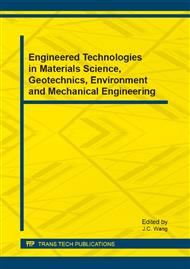[1]
Belegundu, A. D. (1982). A Study of Mathematical Programming Methods for Structural Optimization. PhD thesis, University of Iowa, Dept. of Civil and Environmental Engineering.
Google Scholar
[2]
Rajeev, S. and Krishnamoorthy, C.S., 1992, Discrete Optimization of Structures Using Genetic Algorithms, Journal of Structural Engineering 118, 5, 1233-1250.
DOI: 10.1061/(asce)0733-9445(1992)118:5(1233)
Google Scholar
[3]
M.P. Saka, E. Kameshki, "Optimum Design of Multi-Storey Sway Steel Frames to BS 5950 using a Genetic Algorithm", in B.H.V. Topping, (Editor), "Advances in Engineering Computational Technology", Civil-Comp Press, Edinburgh, UK, pp.135-141, 1998.
DOI: 10.4203/ccp.53.3.6
Google Scholar
[4]
Camp, C. V., Pezeshk, S. and Cao, G. (1998). "Optimized Design of Two-Dimensional Struc-tures Using A Genetic Algorithm," Journal of Structural Engineering, ASCE, Vol. 124, No. 5, 551-559.
DOI: 10.1061/(asce)0733-9445(1998)124:5(551)
Google Scholar
[5]
Pezeshk, S., and C. V. Camp (2002). State of the Art on the Use of Genetic Algorithms in Design of Steel Structures, in Recent Advances in Optimal Structural Design, S. Burns (Editor), American Society of Civil Engineers.
Google Scholar
[6]
Erbatur, F. and Al-Hussainy, M. M. (1992). "Optimum design of frames." Comp. and Struct., 45(5/6), 887-891.
DOI: 10.1016/0045-7949(92)90047-4
Google Scholar
[7]
O.C. Zienkiewicz, R.L. Taylor, J.Z. Zhu: The finite element method: its basis and fundamentals. Elsevier Butterworth-Heinemann, 2005.
Google Scholar
[8]
Shook D. A., et al. (2008). GA-optimized fuzzy logic control of a large scale building for seismic loads. Engineering Structures 2008:30:436-449.
DOI: 10.1016/j.engstruct.2007.04.008
Google Scholar
[9]
Eurocode 3: EN 1993-1-1 Design of steel structures – Part 1-1: general rules and rules for buildings.
Google Scholar
[10]
R. Kicinger, 1989. T. Arciszewski, and K. De Jong. Evolutionary computation and structural design: A survey of the state-of-the-art. Comp. and Struct. 83 (23-24): 1943-1978, 2005.
DOI: 10.1016/j.compstruc.2005.03.002
Google Scholar


